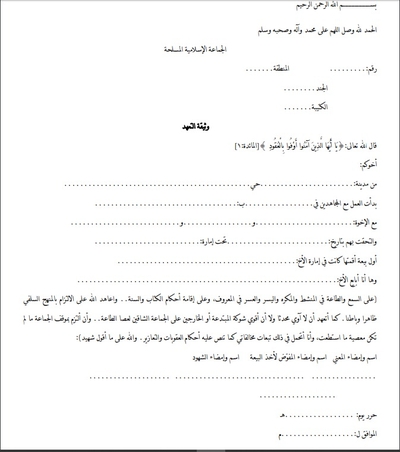As can be seen from the manifesto of the Armed Islamic Group (GIA) published with the signature of Abu Abd al-Rahman Amin (Djamal Zitouni) in Sha'aban 1416 AH (c. late December 1995 CE-late January 1996 CE), the group repeatedly emphasized that it was the sole legitimate Islamic group fighting in its abode of Algeria, and as such required all Muslims within that abode to hear and obey its amir. For those who wanted to work with the GIA as a fighting force inside Algeria and/or formally join the group's ranks, it was required to pledge allegiance and sign a document called wathiqat al-ta'ahhud ("pledge document"). This document is presented in this post.
Unsurprisingly, the document places heavy emphasis on loyalty to the group and not rebelling. The mention of embracing the "Salafi manhaj" is in keeping with the GIA's self-description of its ideological orientation in the manifestation.
The American analyst Brian Fishman asked me an interesting question regarding whether the Islamic State's ideology can be linked to the GIA's extremism. There are certainly similarities between the two groups' emphasis on the allegiance pledge and their approaches to relations on the ground with others. The Islamic State has similarly portrayed itself as the sole legitimate Islamic force. As such, there is ultimately no toleration for the idea of an insurgency consisting of multiple groups: all must come under the authority of one group. It is probably also correct to note a parallel between the GIA and the Islamic State in terms of excessive takfir. Furthermore, like the Islamic State, there is no hint that the GIA accepted the notion of needing a popular support base (hadhina sha'abiya) to implement rulings of Islamic law such as the hudud.
Ultimately though, we are only noting parallels rather than being able to draw a definitive link. Despite the GIA's emphasis on the allegiance pledge, the manifesto and this pledge document do not suggest that the GIA believed it was on the verge of establishing a Caliphate and that the group itself would embody the Caliphate. Rather, the group only affirmed that it was striving towards the goal of establishing a Caliphate- an ambition shared by other jihadi ad Islamist groups. In contrast, pretensions to being the group that would actually embody the Caliphate were evident in the predecessors of the Islamic State, such as the description of Abu Omar al-Baghdadi (first amir of the Islamic State of Iraq) as amir al-mu'mineen ("commander of the believers"). Note also the same title applied to Abu Bakr al-Baghdadi, as well as the descriptions of him as al-Husseini and al-Qurashi even when there was still just the Islamic State of Iraq.
In general, one can draw a contrast between those who believe that only a single group should direct an insurgency (e.g. the GIA and the Islamic State) and those who believe that believe it is advantageous for multiple entities to exist. As Abu Akram Hisham of al-Qa'ida in the Islamic Maghreb suggests, the GIA's approach was partly rooted in drawing a lesson from the failings of infighting in the Afghan jihad after the Soviet withdrawal and fall of the communist/socialist government in 1992. In Syria today, some jihadis in the remaining insurgent-held northwest may believe it is advantageous not to unite as a single entity in the form of e.g. Hay'at Tahrir al-Sham because the existence of multiple groups will allow the jihad to continue in the future despite the fact that in the grand picture the insurgency has lost the war.
Below is the GIA's pledge document with my translation. Like the GIA manifesto, the document is taken from the book Tajliyat al-Raya.

In the name of God, the Compassionate, the Merciful
Praise be to God and may God's blessings and salutations be on Muhammad, his family and companions.
Armed Islamic Group
No.:
Area:
Soldiery:
Battalion:
Pledge Document
God Almighty has said: "Oh you who have believed, fulfill the pacts" (al-Ma'ida 1).
Your brother:
From the town of...neighbourhood of...
I began working with the mujahideen in....in...
With the brothers...and...and...
And I joined them on date...under the command of...
The first allegiance pledge I undertook was in the amirship of the brother...
And here I pledge allegiance to the brother....
(On hearing and obeying, in enthusiasm and compulsion, in ease and adversity on the basis of what is right, and on the basis of establishing the rulings of the Book and the Sunna. And I pledge to God to embrace the Salafi manhaj externally and internally, just as I pledge not to give refuge to an innovator and not to strengthen the power of the innovators or those who revolt against the group in rebellion. And I pledge to embrace the group's position as far as I can so long as there is no act of disobedience. And in that I bear responsibility for the consequences of my contraventions, as per the stipulations of the rulings of punishments and reprimands. And God is witness to what I say).
Name and signature of the person concerned:
Name and signature of the one delegated to take the allegiance pledge:
Name and signature of the witnesses:
Published on day....AH
Corresponding to....CE

